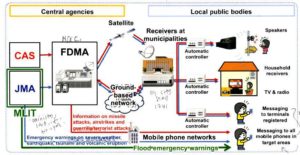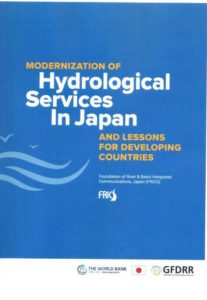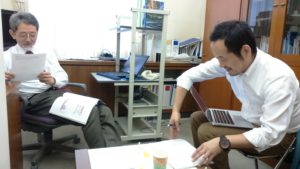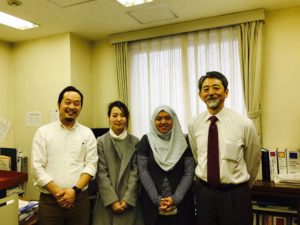AUNSEED-SRJP Visit 2017
16-17 March 2017
Last visit was in Tokyo- FRICS. Dr. Hideyuki Kamimera was the host for my visit. Very in depth discussion about dissemination of early warnings were conducted during the visit. Ir. Minoru Kuriki, Senior Director of FRICS was also present during the discussion. Dr. Kamimera first presented on the history of how the current disaster warning dissemination system is developed. J-Alert was established since 2007. However few municipalities uses the system. After the 2011 tsunami disaster experienced in Tohoku, higher percentage of municipalities use the system. Similar to Malaysia, the improvement of application or development of an early warning system are deployed after a massive and extreme disaster event.
J-alert is a nationwide warning system in Japan. It has been operated by Fire and Disaster Management Agency (FDMA) under the Ministry of Internal Affairs and Communications (MIC). The system disseminates information on civil protection from Cabinet Secretariat (CAS) and the emergency warnings on severe weather, earthquake, tsunami and volcanic eruption from Japan Meteorological Agency (JMA) to residents in real time for rapid evacuation and emergency response.
J-alert System
Other discussion during the FRICS visit is also on implementation after warnings were given. For example, in 2004 a warning was given to the municipal office; however the city mayor at that time was not fully educated about such warning events and proceeded to ignore the warnings to be given to the public. Hence, disaster occurs and lives were lost. One of the steps being done by the Japanese government is to educate not just the people but focused on educating the politicians. Such awareness program is conducted through the Ministry of Land Infrastructure, Transport and Tourism. Improvement of the warning system is also being conducted by involving the public and getting feedbacks from the public regarding existing risk maps developed by the authorities. Such plan is the My time line program. The program includes training course for residents by the disaster management companies. Residents are given risk maps, and are practice to use and identify the routes safe for evacuation. From such programs better reaction of the people from available resources of risk maps can be obtain. Improvement of guidelines by the cabinet was also conducted such as guidelines on when to issue the warnings. A report on what have been made by FRICS and their suggestion and recommendations to other disaster management agencies was shared through their publication Modernization of hydrological services in Japan.
Report related to early warning and what can be done for improvement
Ir Minoru Kuriki and Dr. Hideyuki Kamimera in Ir Minoru Kuriki’s office
A very fruitful meeting and discussion..very humble host




